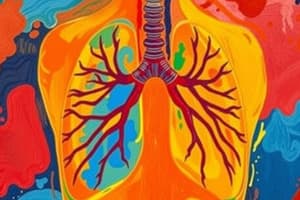Podcast
Questions and Answers
What are the main stages of ventilation?
What are the main stages of ventilation?
Inspiration (Inhalation) and Expiration (Exhalation)
What is the role of the pleural membrane?
What is the role of the pleural membrane?
To cover the lungs
What is the function of the diaphragm?
What is the function of the diaphragm?
It separates the thoracic and abdominal cavities and is a muscular wall that helps with the process of breathing.
Where in the respiratory system does the exchange of gases occur?
Where in the respiratory system does the exchange of gases occur?
What are the characteristic of the walls of the alveoli and blood capillaries that allow for efficient gas exchange?
What are the characteristic of the walls of the alveoli and blood capillaries that allow for efficient gas exchange?
The presence of moisture in the walls of the alveoli hinders the process of gas exchange.
The presence of moisture in the walls of the alveoli hinders the process of gas exchange.
What happens to oxygen as it travels from the lungs to the cells?
What happens to oxygen as it travels from the lungs to the cells?
What happens to carbon dioxide as it travels from the cells to the lungs?
What happens to carbon dioxide as it travels from the cells to the lungs?
What are the three main phases of cellular respiration?
What are the three main phases of cellular respiration?
What are the main products of cellular respiration?
What are the main products of cellular respiration?
What is the primary function of the kidneys in the excretory system?
What is the primary function of the kidneys in the excretory system?
What are the main components of glomerular filtrate?
What are the main components of glomerular filtrate?
What are the main components of urine?
What are the main components of urine?
How is the process of hemodialysis used to help individuals whose kidneys are not functioning properly?
How is the process of hemodialysis used to help individuals whose kidneys are not functioning properly?
What is the main reason for the importance of maintaining a waste-free external environment?
What is the main reason for the importance of maintaining a waste-free external environment?
What are two key steps within the process of kidney donation?
What are two key steps within the process of kidney donation?
Flashcards
Respiration
Respiration
The process by which organisms take in oxygen and release carbon dioxide to produce energy.
Cellular Respiration
Cellular Respiration
The process of breaking down glucose using oxygen to release energy within cells.
Lungs
Lungs
The main organs of respiration in humans, responsible for gas exchange with the blood.
Alveoli
Alveoli
Signup and view all the flashcards
Ventilation
Ventilation
Signup and view all the flashcards
Inspiration (Inhalation)
Inspiration (Inhalation)
Signup and view all the flashcards
Expiration (Exhalation)
Expiration (Exhalation)
Signup and view all the flashcards
Alveolar Exchange of Gases
Alveolar Exchange of Gases
Signup and view all the flashcards
Surfactant
Surfactant
Signup and view all the flashcards
Excretion
Excretion
Signup and view all the flashcards
Protein Metabolism
Protein Metabolism
Signup and view all the flashcards
Ammonia
Ammonia
Signup and view all the flashcards
Urea
Urea
Signup and view all the flashcards
Kidney
Kidney
Signup and view all the flashcards
Nephron
Nephron
Signup and view all the flashcards
Ultrafiltration
Ultrafiltration
Signup and view all the flashcards
Reabsorption
Reabsorption
Signup and view all the flashcards
Secretion
Secretion
Signup and view all the flashcards
Hemodialysis
Hemodialysis
Signup and view all the flashcards
Kidney Transplantation
Kidney Transplantation
Signup and view all the flashcards
Homeostasis
Homeostasis
Signup and view all the flashcards
Contractile Vacuole
Contractile Vacuole
Signup and view all the flashcards
Nephridia
Nephridia
Signup and view all the flashcards
Malpighian Tubules
Malpighian Tubules
Signup and view all the flashcards
Skin Excretion
Skin Excretion
Signup and view all the flashcards
Anaerobic Respiration
Anaerobic Respiration
Signup and view all the flashcards
Glycolysis
Glycolysis
Signup and view all the flashcards
Krebs Cycle
Krebs Cycle
Signup and view all the flashcards
Study Notes
Respiration and Excretion
- Human respiratory system: The human respiratory system comprises the lungs, bronchioles, alveoli, and associated structures. It's responsible for gaseous exchange.
- Gaseous exchange: The exchange of oxygen and carbon dioxide between the air and the blood occurs in the alveoli.
- Cellular respiration: A series of metabolic reactions where glucose is broken down to release energy in the form of ATP. Oxygen is required.
- Respiration in other organisms: Different organisms have varying respiratory mechanisms, including gaseous exchange through skin, gills, or specialized organs.
- Synthesis of urea: A metabolic process converting ammonia (a toxic byproduct of protein metabolism) to urea in the liver.
- Formation of urine: Involves several processes: ultrafiltration (forming filtrate), reabsorption (returning vital substances to the blood), and secretion (adding substances from blood to filtrate).
- Excretion in plants: Plants excrete waste products such as excess water, gases (O2, CO2), and some salts through stomata and lenticels.
- Hemodialysis: A procedure used to filter waste products from the blood when the kidneys fail, using a machine to filter blood externally.
- Kidney transplantation: Replacement of a diseased kidney with a healthy donor kidney.
- Homeostasis: The maintenance of stable internal conditions in the body, aided by the respiratory and excretory systems.
Respiration
- What is respiration? The process of exchanging oxygen and carbon dioxide, also the breaking down of glucose. Lavoisier's experiments demonstrated similarities between burning and respiration.
- Role of oxygen: Essential for respiration and also for burning processes.
- Products of respiration: Carbon dioxide and energy (ATP).
Respiratory Surface in Human Beings
- Alveoli: Tiny air sacs in the lungs, with a large surface area for efficient gas exchange.
- Structure: Delicate elastic walls, extensive network of blood capillaries.
- Details: Approximately 70 million alveoli in total, contributing to a large respiratory surface area (approximately 70 m²).
Ventilation
- Definition: The movement of air into and out of the lungs.
- Inspiration: Inhaling; air entering the lungs.
- Expiration: Exhaling; air leaving the lungs.
- Intercostal muscles: Muscles between the ribs that aid in expanding and contracting the chest cavity, changing lung volume.
- Ribs: The moving and expanding of ribs changes the size of the thoracic cavity.
- Diaphragm: A muscular sheet separating the thoracic and abdominal cavities which also aids in breathing and controls lung volume.
Alveolar Exchange of Gases
- Process: Oxygen from the alveoli diffuses into the blood (capillaries), and carbon dioxide from the blood diffuses into the alveoli.
- Factors: Gaseous exchange is facilitated by the thin walls of the alveoli and blood capillaries, and the concentration gradient of gases. The moisture in the alveoli aids smooth gas diffusion.
- RBCs: Red blood cells carry oxygen and play a major role, hemoglobin transports gases.
- Concentration of O2 and CO2: High O2 concentration in alveoli drives its diffusion into the blood, similarly high CO2 concentration in blood drives its diffusion into the alveoli.
Surfactant
- Function: The substances inside the alveoli help them to expand easily and contract slowly when air enters and leaves the lungs.
- Importance: Ensuring smooth breathing and preventing lung collapse, particularly crucial in premature babies.
Respiration in Other Organisms
- Variety: Organisms utilize various respiratory organs and mechanisms for gas exchange.
- Examples: Amoeba (simple diffusion), earthworms (skin), fish (gills), frogs (skin and lungs), reptiles and birds (lungs).
- Role of body Systems: Different body systems support breathing in different species, such as the skin in earthworms and lungs in mammals.
Urea Synthesis
- Purpose: The liver converts ammonia (toxic) to urea, a less toxic product.
- Process: Enzymes in the liver catalyze the combination of ammonia with carbon dioxide and water, resulting in the formation of urea.
- Liver role: Central organ in urea synthesis.
Kidney and Related Parts
- Function: Filtration of blood. Essential for removing waste materials and excreting water and various salts.
- Nephrons: The functional unit of the kidney. These small structures are located inside the kidney.
- Components: Glomerulus, Bowman's capsule, renal tubules, collecting ducts.
Urine Formation
- Ultrafiltration: The beginning phase in urine formation, where a filter acts on the blood, separating water and small soluble components, creating a filtrate.
- Reabsorption: The reabsorbing of essential components back into the blood.
- Secretion: The secretion of excess materials to be removed from the body happens into the filtrate from the blood.
Kidney Transplantation
- Requirements: A suitable donor and recipient where both have matched blood group and specific tissue matching.
- Procedure: Surgery involves connecting the donor's kidney blood vessels to the recipient's circulatory system.
- Post-Surgery considerations: Medication is required to prevent rejection and follow up checkups are essential for proper functioning.
Hemodialysis
- Alternative treatment: Procedure for blood purification used when the kidneys fail.
- Process: Blood is passed through tubes with a semi-permeable membrane; waste materials are removed, and purified blood is sent back into the body.
Homeostasis
- Definition: The maintenance of stable internal conditions.
- Role of organs: Several organs, like lungs, skin, and kidneys, are essential for homeostasis maintenance.
- Examples: Regulation of blood pH, temperature, water balance, and metabolic wastes.
External Environment and Pollution
- Threats: Harmful influences on the external environment include poor diet, substances, lack of exercise etc.
- Impacts: The impacts associated with harmful habits such as smoking, substance abuse etc.
Waste Free New Kerala
- Role Play: Emphasize proactive waste minimization and environmental protection in daily activities.
Human Health
- Diagnosis: Urine tests or analysis can uncover some diseases affecting the body.
Studying That Suits You
Use AI to generate personalized quizzes and flashcards to suit your learning preferences.



